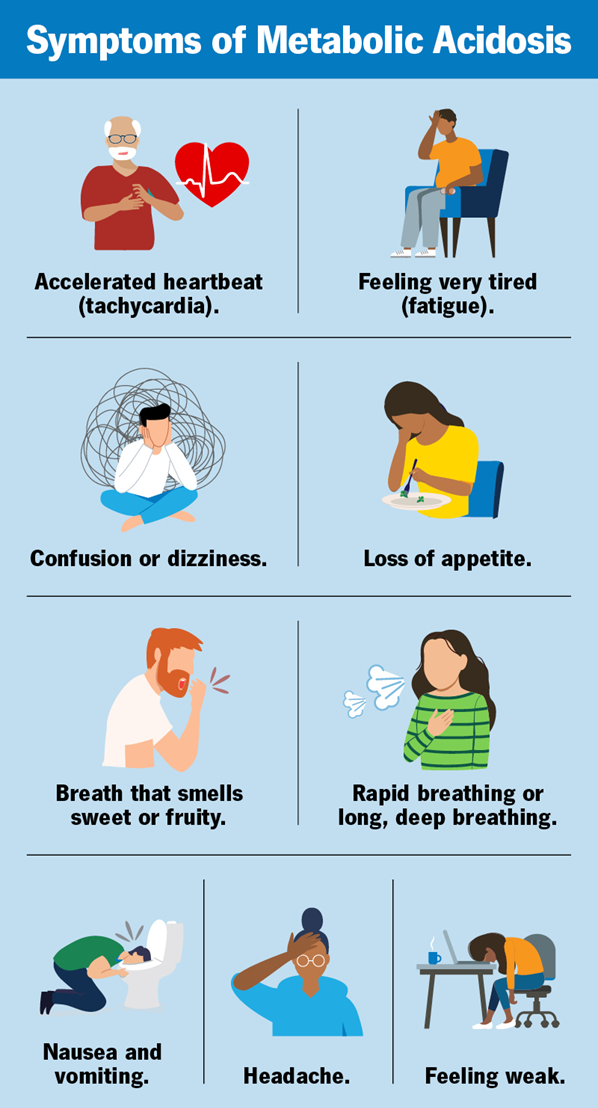A nurse is caring for a client who has the following arterial blood gas results: HCO3 18 mEq/L, PaCO2 28 mm Hg, and pH 7.30. The nurse recognizes the client is experiencing which of the following acid-base imbalances?
Metabolic alkalosis
Respiratory alkalosis
Respiratory acidosis
Metabolic acidosis
The Correct Answer is D
Choice A Reason:
Metabolic alkalosis is characterized by an elevated pH (greater than 7.45) and an increased bicarbonate (HCO3) level. In this case, the pH is 7.30, indicating acidosis, and the HCO3 level is 18 mEq/L, which is below the normal range (22-26 mEq/L). Therefore, metabolic alkalosis is not the correct diagnosis.
Choice B Reason:
Respiratory alkalosis is indicated by a high pH (greater than 7.45) and a low PaCO2 (less than 35 mm Hg). Although the PaCO2 is low at 28 mm Hg, the pH is 7.30, indicating acidosis rather than alkalosis. Therefore, respiratory alkalosis is not the correct diagnosis.
Choice C Reason:
Respiratory acidosis is characterized by a low pH (less than 7.35) and an elevated PaCO2 (greater than 45 mm Hg). In this case, the pH is low, indicating acidosis, but the PaCO2 is also low at 28 mm Hg, which does not fit the criteria for respiratory acidosis. Therefore, respiratory acidosis is not the correct diagnosis.
Choice D Reason:
Metabolic acidosis is indicated by a low pH (less than 7.35) and a low bicarbonate (HCO3) level (less than 22 mEq/L). In this case, the pH is 7.30, indicating acidosis, and the HCO3 level is 18 mEq/L, which is below the normal range. The low PaCO2 of 28 mm Hg suggests a compensatory respiratory response to the metabolic acidosis. Therefore, metabolic acidosis is the correct diagnosis.

Nursing Test Bank
Naxlex Comprehensive Predictor Exams
Related Questions
Correct Answer is C
Explanation
Choice A Reason:
Nonfat milk is generally considered safe for individuals with GERD. While full-fat dairy products can exacerbate GERD symptoms due to their high-fat content, nonfat milk does not have this effect. It is low in fat and unlikely to trigger acid reflux. Therefore, nonfat milk is not a food that needs to be avoided by someone with GERD.
Choice B Reason:
Apples are typically safe for individuals with GERD. In fact, non-citrus fruits like apples are often recommended as part of a GERD-friendly diet. They are low in acid and unlikely to cause reflux symptoms. Therefore, apples do not need to be avoided by someone with GERD.
Choice C Reason:
Chocolate is a common trigger for GERD symptoms. It contains caffeine and theobromine, both of which can relax the lower esophageal sphincter (LES), allowing stomach acid to escape into the esophagus and cause reflux. Additionally, chocolate is high in fat, which can further exacerbate GERD symptoms. Therefore, it is advisable for individuals with GERD to avoid chocolate to prevent worsening of their symptoms.
Correct Answer is A
Explanation
Choice A Reason:
0.45% sodium chloride (half-normal saline) is an appropriate solution for treating hypernatremia, especially in a client who is NPO (nothing by mouth). This hypotonic solution helps to gradually reduce the serum sodium levels by providing free water to the extracellular space, which dilutes the high sodium concentration. It is essential to administer this solution slowly to avoid rapid shifts in fluid balance, which can lead to cerebral edema.
Choice B Reason:
Dextrose 5% in 0.9% sodium chloride (D5NS) is not the best choice for treating hypernatremia. While it provides some free water, the presence of 0.9% sodium chloride makes it an isotonic solution, which does not effectively lower serum sodium levels. This solution is more suitable for maintaining fluid balance rather than correcting hypernatremia.
Choice C Reason:
Lactated Ringer’s is also not appropriate for treating hypernatremia. This isotonic solution contains electrolytes, including sodium, which can exacerbate hypernatremia rather than correct it. Lactated Ringer’s is typically used for fluid resuscitation and electrolyte replacement in other clinical scenarios.
Choice D Reason:
Dextrose 10% in water (D10W) is a hypertonic solution and is not suitable for treating hypernatremia. While it provides free water, the high concentration of dextrose can lead to rapid shifts in fluid balance and potential complications such as hyperglycemia. This solution is generally used for providing calories and preventing hypoglycemia in specific clinical situations.
Whether you are a student looking to ace your exams or a practicing nurse seeking to enhance your expertise , our nursing education contents will empower you with the confidence and competence to make a difference in the lives of patients and become a respected leader in the healthcare field.
Visit Naxlex, invest in your future and unlock endless possibilities with our unparalleled nursing education contents today
Report Wrong Answer on the Current Question
Do you disagree with the answer? If yes, what is your expected answer? Explain.
Kindly be descriptive with the issue you are facing.
